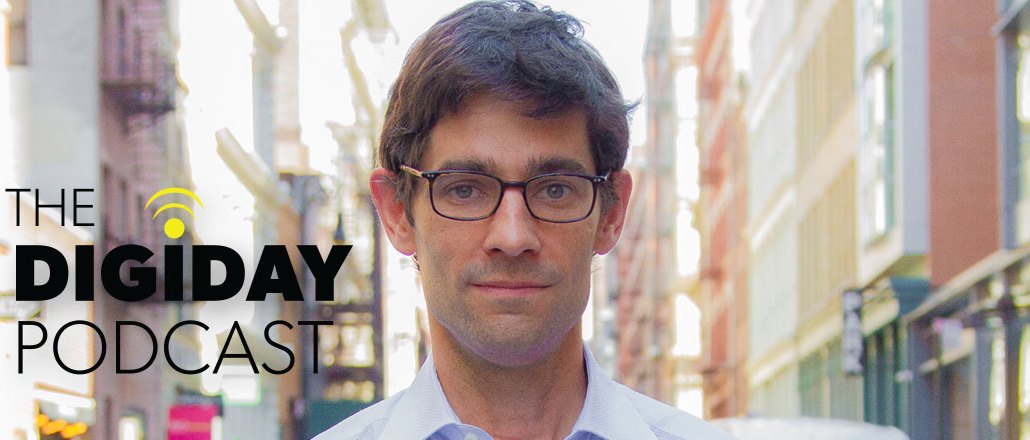Save 50% on a 3-month Digiday+ membership. Ends Dec 12.

The New Yorker is a true legacy media brand. The magazine has been published for more than nine decades and has produced some of the finest writing across multiple generations. Now, like all publishers, The New Yorker is in the midst of adapting that legacy to the digital world.
Nicholas Thompson, a former features editor at the magazine, leads that effort as editor of NewYorker.com. In his role, Thompson essentially publishes a daily version of The New Yorker attuned to the rhythms and mores of the digital world, while also figuring out products like The New Yorker’s recently released mobile app.
“There are a lot of things that other media companies do that we don’t do because we’re not convinced The New Yorker brand works there or we can be really good,” he said on this week’s episode of the Digiday Podcast. “If you’re The New Yorker, what’s the point of going into something new if you can’t do it really well.”
Below are highlights, edited for clarity, from the half-hour conversation.
The New Yorker doesn’t have the luxury of sucking.
Digital media has often rewarded those who move fast in digital media, even if the quality isn’t quite there. Look no further than Facebook video, where publishers are busily torturing fruit for giant live audiences. But legacy publishers have set the bar of expectations high for users. That means being thoughtful at all times about the brand.
“You put out a post on The New Yorker website, and all these great things from the history come with it,” he said. “It’s in a font they recognize, in a style they recognize, they see the name New Yorker on the top of it. They think all these wonderful thoughts about the magazine. You get this great benefit of the brand.”
With great brands, though, come great responsibilities. “The cost is you don’t want to blow it all up,” he added. “You don’t want to publish something terrible. You don’t want the website to change the warm feelings everybody has to The New Yorker institution. It’s a real challenge. You have to be good from the beginning. Everything you publish every day has to live up to the standards of the magazine.”
Some magazine writers aren’t good at web writing.
Some magazine writers — and The New Yorker has 40 of the best in the business — are not good at fast-twitch writing for the web. But, Thompson said, that’s not an old versus young equation. Rather than force bad fits, The New Yorker tries to play to writers’ strengths.
“Some of them love writing for the website,” he said. “They’re great at it. They’re happy to do it. It’s not dependent on whether they’re young and techie. Roger Angell is 95 years-old and loves blogging. He’s great at it. There are other young people with wonderful Twitter feeds who don’t love blogging.”
“The brand has shifted a ton.”
Thompson started at The New Yorker six years ago as a features editor. In that role, he’d work with a stable of eight writers doing four or five deeply reported, long pieces a year. Then, in 2012, he shifted to run The New Yorker’s website as it began to take the Web seriously. The site now drew nearly 11 million visitors in March, according to comScore, and last month released a new iPhone app. The New Yorker even has a Snapchat account.
“The site has become massively more ambitious,” Thompson said. “There has been much more attention focused on it. The staff has grown. The dynamics have changed.”
The New Yorker’s site is a daily version of the magazine.
Many magazines made the early mistake of treating websites as storefronts for magazine subscriptions. They’d repurpose magazine stories there behind paywalls. While The New Yorker wants to drive subscriptions above all else, it views the site as an extension of the weekly product, with its own unique mix that draws on the magazine and adds in unique digital content.
“We’re not looking at Facebook trends or Twitter trends when we’re doing our story meetings, but we want to be current,” he said. “We’re not in that game. We’re not rewriting. We’re not trying to beat people. But we’re also not just smoking our pipes on a hill.”
More in Media

Workforce data, smarter AI integration among greatest workplace priorities in the new year
The growing importance of workforce data is just one of the prognostications people managers are making looking to the year ahead.

WTF is AI citation tracking?
Publishers are tracking AI citations to understand visibility, attribution gaps and referral traffic in these tools and platforms.

As big brands flood the podcast ad space, startups are refining strategies to stand out
While a influx of big advertisers is good news for podcast companies, it also makes it more challenging for small- to mid-sized brands to stand out in the space.





